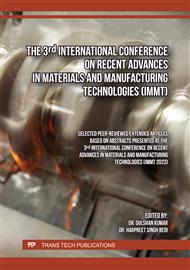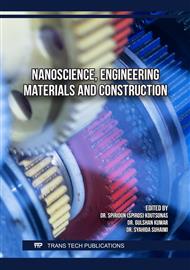p.3
p.11
p.21
p.29
p.39
p.51
p.59
p.79
Deformation Behaviour of SWCNT and MWCNT under Torsional Loading: Insights from Molecular Dynamics
Abstract:
This study investigates the mechanical behavior of single and multi-wall carbon nanotubes (SWCNT/MWCNT) during torsional loading using the molecular dynamics (MD) simulation technique. The open-source software Large-Scale Atomic/Molecular Massively Parallel Simulator (LAMMPS) is utilized to conduct MD simulations to gain valuable insights into the response of pristine and defective carbon nanotubes. The torsional behavior of armchair SWCNTs with chiralities (5,5); (7,7); (10,10); (12,12) and (15,15) and zigzag SWCNTs (12,0); (17,0) and (22,0) is explored to understand the effect of chirality on the torsional properties. Furthermore, the impact of the aspect ratio is examined by varying the diameter of SWCNTs while keeping the length constant. The findings reveal a notable decrease in shear modulus with increasing tube diameter, providing a crucial understanding of the torsional behavior concerning SWCNT geometry. To assess the effect of vacancy defects, 1%, 2%, and 4% vacancy defects are introduced on (10,10) armchair SWCNTs, and their torsional response is analyzed. The predictions highlight a significant reduction in shear modulus by 25% for SWCNTs with the rising concentration of vacancy defects from 1% to 4%. Overall, this study contributes to a deeper comprehension of the mechanical properties of carbon nanotubes under torsional loading, paving the way for potential applications in nanotechnology and nanocomposite design.
Info:
Periodical:
Pages:
21-28
Citation:
Online since:
April 2025
Authors:
Keywords:
Price:
Сopyright:
© 2025 Trans Tech Publications Ltd. All Rights Reserved
Share:
Citation:



